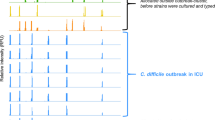Abstract
Immunoblotting and pulsed-field gel electrophoresis of Clostridium difficile isolates were employed to differentiate reinfection by a newly acquired strain from relapse by an original strain in a 10-year-old patient with four episodes of C. difficile-associated colitis. Immunoblot typing demonstrated subserogroup K-1 of serogroup K for the first and second organisms, subserogroup A-1 of serogroup A for the third organism, and subserogroup G-4 of serogroup G for the fourth organism. PFGE analysis revealed consistent results with immunoblot analysis except that the strains from the fourth episode, whose DNA constantly degraded, were nontypable by this method. Five separate isolates of C. difficile from a specimen of each episode showed identical PFGE patterns, indicating that infections of multiple strains probably did not occur in this patient. These typing results suggested that the second episode after a 17-day course of vancomycin therapy represented a relapse by the strain causing the first episode, and that the third and fourth episodes after tapering vancomycin therapy were reinfections by other strains. Both immunoblot and PFGE typing systems are promising tools for analyzing recurrence of C. difficile infection.
Similar content being viewed by others
Literature Cited
Allen SD, Baron EJ (1991) Clostridium. In: Balows A, Hausler WJ Jr, Herrmann KL, Isenberg HD, Shadomy HJ (eds) Manual of clinical microbiology, 5th ed. Washington, D.C.: American Society for Microbiology, pp 505–521
Bartlett JG (1992) Antibiotic-associated diarrhea. Clin Infect Dis 15: 573–581
Bordello SP, Wren BW, Hyde S, Seddon SV, Sibbons P, Krishna MM, Tabaqchali S, Manek S, Price AB (1992) Molecular, immunological, and biological characterization of a toxin A-negative, toxin B-positive strain of Clostridium difficile. Infect Immun 60: 4192–4199
Clabots CR, Johnson S, Bettin KM, Mathie PA, Mulligan ME, Shaberg DR, Peterson LR, Gerding DN (1993) Development of a rapid efficient restriction endonuclease analysis typing system for Clostridium difficile and correlation with other typing systems. J Clin Microbiol 31: 1870–1875
Delmee M, Homel M, Wauters G (1985) Serogrouping of Clostridium difficile strains by slide agglutination. J Clin Microbiol 21: 323–327
Delmee M, Laroche Y, Avesani V, Cornells G (1986) Comparison of serogrouping and polyacrylamide gel electrophoresis for typing Clostridium difficile. J Clin Microbiol 24: 991–994
Gorbach SL, Chang T-W, Goldin B (1987) Successful treatment of relapsing Clostridium difficile colitis with Lactobacillus GG. Lancet 1519
Johnson S, Adelmann A, Clabots CR, Peterson LR, Gerding DN (1989) Recurrences of Clostridium difficile diarrhea not caused by the original infecting organism. J Infect Dis 159: 340–343
Kato H, Cavallaro JJ, Kato N, Bartley SL, Killgore GE, Watanabe K, Ueno K (1993) Typing of Clostridium difficile by Western immunoblotting with 10 different antisera. J Clin Microbiol 31: 413–415
Kato H, Kato N, Watanabe K, Ueno K, Ushijima H, Hashira S, Abe T (1994) Application of typing by pulsed-field gel electrophoresis to the study of Clostridium difficile in a neonatal intensive care unit. J Clin Microbiol 32: 2067–2070
Kato N, Ou C-Y, Kato H, Bartley SL, Brown VK, Dowell VR Jr, Ueno K (1991) Identification of toxigenic Clostridium difficile by the polymerase chain reaction. J Clin Microbiol 29: 33–37
Kristjánsson M, Samore MH, Gerding DN, DeGirolami PC, Bettin KM, Karchmer AW, Arbeit RD (1994) Comparison of restriction endonuclease analysis, ribotyping, and pulsed-field gel electrophoresis for molecular differentiation of Clostridium difficile strains. J Clin Microbiol 32: 1963–1969
Kunimoto D, Thomson ABR (1986) Recurrent Clostridium difficile-associated colitis responding to cholestyramine. Digestion 33: 225–228
Leung DYM, Kelly CP, Boguniewicz M, Pothoulakis C, LaMont JT, Flores A (1991) Treatment with intravenously administered gamma globulin of chronic relapsing colitis induced by Clostridium difficile toxin. J Pediatr 118: 633–637
O’Neill GL, Beaman MH, Riley TV (1991) Relapse versus reinfection with Clostridium difficile. Epidemiol Infect 107: 627–635
Schwan A, Sjolin S, Trottestam U, Aronsson B (1984) Relapsing Clostridium difficile enterocolitis cured by rectal infusion of normal faeces. Scand J Infect Dis 16: 211–215
Summanen P, Baron EJ, Citron DM, Strong C, Wexler HM, Finegold SM (eds) (1993) Wadsworth anaerobic bacteriology manual, 5th ed. Belmont, California: Star Publishing Co.
Surawicz CM, McFarland LV, Elmer G, Chinn J (1989) Treatment of recurrent Clostridium difficile colitis with vancomycin and Saccharomyces boulardii. Am J Gastroenterol 84: 1285–1287
Tedesco FJ, Gordon D, Fortson WC (1985) Approach to patients with multiple relapses of antibiotic-associated pseudomembranous colitis. Am J Gastroenterol 80: 867–868
Toma S, Lesiak G, Magus M, Lo H-L, Delmee M (1988) Serotyping of Clostridium difficile. J Clin Microbiol 26: 426–428
Wilcox MH, Spencer RC (1992) Clostridium difficile infection: responses, relapses and re-infections. J Hosp Infect 22: 85–92
Author information
Authors and Affiliations
Rights and permissions
About this article
Cite this article
Kato, H., Kato, N., Watanabe, K. et al. Relapses or reinfections: Analysis of a case of Clostridium difficile-associated colitis by two typing systems. Current Microbiology 33, 220–223 (1996). https://doi.org/10.1007/s002849900103
Received:
Revised:
Accepted:
Issue Date:
DOI: https://doi.org/10.1007/s002849900103




